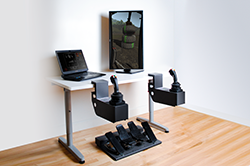CIS Demo Event Attendees Praise the Benefits of Training with a CM Labs Crane Simulator
 Crane Industry Services, LLC recently took delivery of a Vortex Edge Plus portable crane training simulator produced by CM Labs Simulations. To welcome the arrival of the new simulator, CIS hosted a demonstration event with CM Labs at the CIS Centered on Safety facility in Carrollton, Ga. The portable crane operations simulator garnered a lot of attention during the event, reports LD Stutes of CM Labs and Debbie Dickinson, CEO of Crane Industry Services.
Crane Industry Services, LLC recently took delivery of a Vortex Edge Plus portable crane training simulator produced by CM Labs Simulations. To welcome the arrival of the new simulator, CIS hosted a demonstration event with CM Labs at the CIS Centered on Safety facility in Carrollton, Ga. The portable crane operations simulator garnered a lot of attention during the event, reports LD Stutes of CM Labs and Debbie Dickinson, CEO of Crane Industry Services.
In attendance were representatives from IUOE Local 926, Oak Ridge National Laboratory, the Georgia Department of Transportation, as well as regional and national construction and highway companies.
Since 2016, CIS has used a full-size simulator which is the forerunner to the Vortex Advantage, produced by CM Labs. The Vortex Advantage is an immersive training simulator with a plug-and-play training platform that is scalable to training needs and customizable to the crane fleet. In contrast, the new Vortex Edge Plus is designed for simple transport and set-up. “The desktop-style simulator is portable, making it easier for training organizations to bring simulator training to their clients’ locations,” said David Clark, content manager, CM Labs Simulators. “It is equipped to run any CM Labs training module, which includes mobile cranes, tower cranes, forklifts, and earthmoving equipment.”
“During the event, there was a lot of discussion about how expensive it is to train an operator,” said Dickinson. “With a simulator, one person can be trained much faster and more economically than in the cab of a crane.” The self-guided programs are progressive in nature, and capture operator metrics, for valuable feedback, explains Clark. CIS sends a simulator technician, who is also a certified instructor and certified crane operator, to set up the portable simulator in different locations. The instructor handles the technical side of the machine and can simultaneously coach the trainees. The simulator-based training reduces the man hours to train to a 3: or 4:1 ratio, and does not require job site supervisors or rigging crews for the training exercise, or valuable equipment time.
Demo event attendee Nathan Sauls, corporate health and safety director for Brooks Berry Haynie and Associates (BBH), an electrical contractor based in Mableton, Ga., said he can see many advantages to incorporating a simulator into crane operator training. For BBH, the biggest is in screening the qualifications of potential new hires. “I tried both the portable and permanent machines at the CIS event. I can see BBH, in the future, using that technology to set a baseline for hiring operators. It’s definitely got some good qualities for that purpose.”
He says it’s an expensive investment to hire personnel who may not have as much experience as they claim. Currently, BBH’s pre-hire screening involves comparing the skills of the potential employee to an operator they know is qualified. “It can be a financial drain if you spend money hiring someone and putting them in the field only to find out they’re not all they’re cracked up to be. With a simulator you can set a baseline on that good operator,” says Sauls.
Mark Templeton, business manager for the IUOE Local 926 in Rex, Ga., says training on the simulator is a realistic experience. “The motion, the seat moving around, giving you the effect of a real-life crane cab experience impressed me,” he said. “I’m a crane operator myself and the effect was realistic. We have a CM Labs simulator at the IUOE international training site and I’ve been able to get on it.” He believes the tabletop models are good for learning a crane’s functions, such as LMI readings, and better understanding the particular crane’s operations. “But the big system, that gives you the seat simulation, the movement and the motion, is dead on to what you’re going to get in the cab of a crane.”
A crane operator would pick up skills more quickly with a simulator, believes Templeton. “There are more things he can be aware of, and different skills that can be taught, in that situation,” he says, noting he’s spent 20 years in crane operations in the field and has worked around cranes of all types. “Your initial fears of being in a crane and the risks involved in operating heavy machinery—you take that risk factor out when you practice using a simulator, and you avoid the chance of damaging the equipment.”
Illustrating that point exactly, CIS reported that shortly after the CM Labs demo event, a customer utilized the cab-style simulator to prepare for a rough-terrain crane practical exam for crane operator certification. The operator had several months of job-related experience before starting the training. After spending about 40 hours on the Vortex simulator and 10 hours on an actual crane in the yard, the operator was able to pass the practical exam on the first try.
“Many trainees would require more time in the seat to pass the practical exam from the cab of a real crane, which further validates the quality of the simulator training experience,” Dickinson noted.
